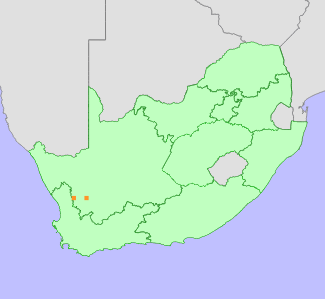|
Scientific Name | Hesperantha rivulicola Goldblatt |
Higher Classification | Monocotyledons |
Family | IRIDACEAE |
National Status |
Status and Criteria | Endangered B1ab(i,ii,iii,iv,v)+2ab(i,ii,iii,iv,v) |
Assessment Date | 2021/06/22 |
Assessor(s) | D. Raimondo, E. Marinus & T. Patel |
Justification | This species has an extent of occurrence (EOO) of 795 km², and an area of occupancy (AOO) of 20 km². It is known historically from four locations. One location in the town of Nieuwoudtville was destroyed by the municipality's road and river maintenance activities in 2003. Currently, it is known from three extant locations. There are ongoing threats from livestock overgrazing and potentially from ploughing to the remaining three subpopulations. It is therefore listed as Endangered under criterion B. |
Distribution |
Endemism | South African endemic |
Provincial distribution | Northern Cape |
Range | It is endemic to South Africa, and is restricted to the Bokkeveld Mountains and Hantamsberg in the Calvinia District of Northern Cape. It is found on several farms near Nieuwoudtville and on the Hantamsberg, both on the lower slopes and summit plateau. |
Habitat and Ecology |
Major system | Terrestrial |
Major habitats | Hantam Karoo, Nieuwoudtville Shale Renosterveld, Hantam Plateau Dolerite Renosterveld, Nieuwoudtville-Roggeveld Dolerite Renosterveld |
Description | It occurs among rocks in seasonal watercourses on sandy, shale or dolerite substrates. |
Threats |
| The two vegetation types that this species occurs in around Nieuwoudtville (Nieuwoudtville Ceres Renosterveld Table Mountain Sandstone transition and Nieuwoudtville Tillite Table Mountain Sandstone transition) are 63% and 75% transformed respectively from wheat and olive farming. Olive groves are an immediate threat to the Papkuilsfontein population.In 2003, the Nieuwoudtville town population was destroyed by the municipality scraping soil (E. Marinus 2003). This species is also threatened by habitat destruction as the seeps and streams are used extensively by livestock; wetland areas are also ploughed for the planting of crops (current, continuing threat) (P. Goldblatt 2005). Climate change is likely to have a major impact on this species due to its dependence on seasonally moist drainage lines (D. Raimondo 2006). |
Population |
There are three known extant subpopulations. The number of individuals in each population is unknown, but the total population size is expected to be at least 10 000 individuals. The population exhibits a decreasing trend.
|
Population trend | Decreasing |
Assessment History |
Taxon assessed |
Status and Criteria |
Citation/Red List version | | Hesperantha rivulicola Goldblatt | EN B1ab(ii,iii,iv,v)+2ab(ii,iii,iv,v) | Raimondo et al. (2009) | | Hesperantha rivulicola Goldblatt | Rare | Hilton-Taylor (1996) | |
Bibliography |
Goldblatt, P. 2003. A synoptic review of the African genus Hesperantha (Iridaceae: Crocoideae). Annals of the Missouri Botanical Garden 90(3):390-443.
Goldblatt, P. and Manning, J.C. 2000. Cape Plants: A conspectus of the Cape Flora of South Africa. Strelitzia 9. National Botanical Institute, Cape Town.
Goldblatt, P. and Manning, J.C. 2020. Iridaceae of southern Africa. Strelitzia 42. South African National Biodiversity Institute, Pretoria.
Hilton-Taylor, C. 1996. Red data list of southern African plants. Strelitzia 4. South African National Botanical Institute, Pretoria.
Raimondo, D., von Staden, L., Foden, W., Victor, J.E., Helme, N.A., Turner, R.C., Kamundi, D.A. and Manyama, P.A. 2009. Red List of South African Plants. Strelitzia 25. South African National Biodiversity Institute, Pretoria.
|
Citation |
| Raimondo, D., Marinus, E. & Patel, T. 2021. Hesperantha rivulicola Goldblatt. National Assessment: Red List of South African Plants version . Accessed on 2025/09/10 |
 Comment on this assessment
Comment on this assessment


